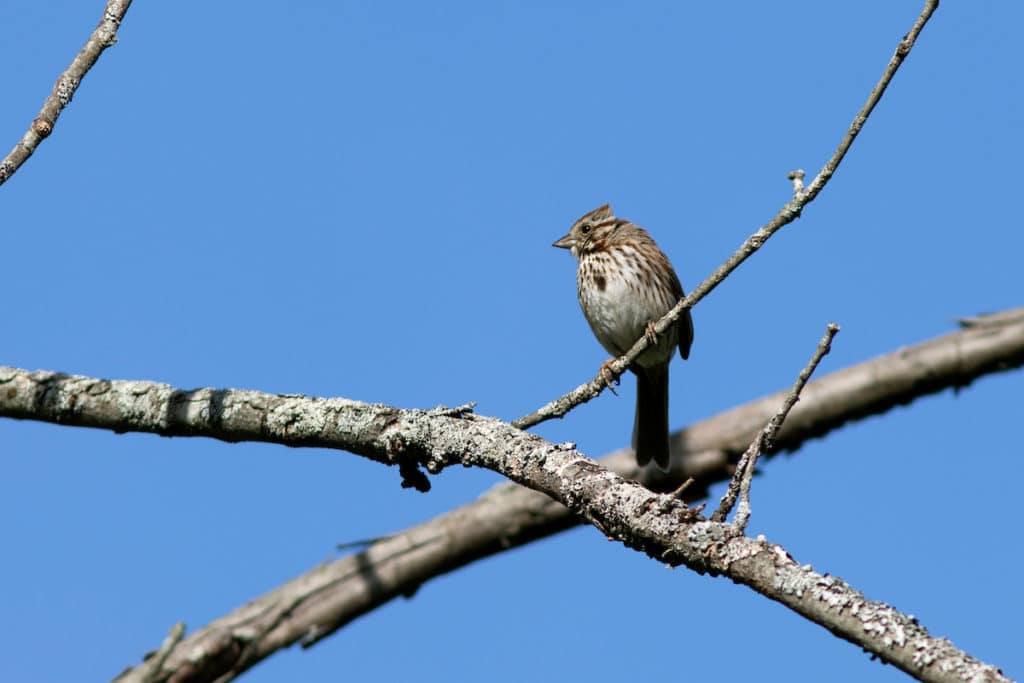
It’s not always easy to identify Maine’s most beloved birds. Maine Audubon biologists and naturalists commonly field identification questions along the lines of “is it this, or is it that?” Many species look similar from a distance, but there are some great telltale signs, both visual markers and behaviors, that can help identify species. This is an occasional series to try to help you know what you are looking at!
Cold Weather Sparrows (Little Brown Birds)
The cold weather of autumn brings small birds like sparrows into our yards, gardens, and parks in foraging flocks. These “little brown birds” and their common associates like finches can be found in a variety of open and shrubby habitats, especially along edges where forest and meadow meet. Sparrows are regularly seen in suburban yards and visit feeders (or the ground below feeders) and provide ample opportunities for observation and study. Their similarities in habit and plumage can cause confusion, but it is possible to distinguish them all with practice.
Not sparrows
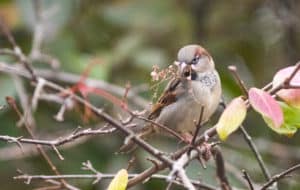
It is probably best to start learning sparrows by learning what are NOT sparrows. The most confusing are the finches—like House Finches, Purple Finches, American Goldfinches, Common Redpolls, and Pine Siskins—as well as the House Sparrows, which belong to the Passeridae family that includes the Old World (Eurasian) Sparrows. These latter are more closely related to the North American finches (Fringillidae) than sparrows.
This is a useful distinction, since House Sparrows share shape and habits with the equally common House Finch. Both species, in addition to the less common Purple Finch, differ from sparrows in that they spend most of their time off the ground, perched on feeders and branches. Generally, at bird feeders or feeding stations, House Sparrows and most finches will be perching on tube feeders while the North American sparrows will be on the ground, pecking and scratching for seeds.
When similar habits confuse you, look to colors for guidance. House Sparrows and all of our common finch species can be distinguished from sparrows by their generally tan coloration. Females of these species are especially sparrow-like, with tan plumage and streaking on their sides and backs, but are all generally lighter in color than the rich browns of our native sparrows. Many also have more heavily notched tails, and often flutter briefly before landing on feeders. American Goldfinches, Common Redpolls, and Pine Siskins are common at feeders in winter, but are all relatively smaller and generally more tan than sparrows.
Sparrows
During fall and winter in Maine, you’re likely to encounter four groups of sparrows:
- Dark-eyed Juncos;
- Song Sparrows and lookalikes;
- White-throated Sparrows and White-crowned Sparrows; and
- American Tree Sparrows and lookalikes.
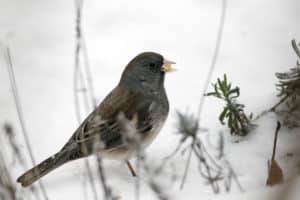
Dark-eyed Juncos are the most distinguishable of our native sparrows, and are familiar to nearly anyone who keeps feeders out during the winter months. They frequently forage on the ground near feeding stations and forest edges and are uniformly gray above and flash white outer tail feathers when flushed. They share habits with most of the other sparrow species, but look so different that they rarely present an identification challenge.
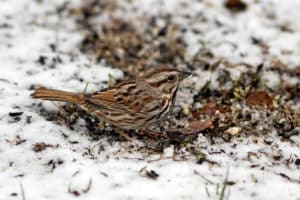
Song Sparrows belong to the genus Melospiza, along with Swamp Sparrows and Lincoln’s Sparrows. For comparison, it is useful to group these Melospiza sparrows with Savannah and Fox Sparrows, which also have brown streaking and brown throat stripes. Within this group, Song Sparrows are the only species that is common throughout the winter in Maine, generally concentrated in coastal and southern Maine, while the rest are more commonly seen during migration. Song Sparrows are striped warm brown and gray above with coarse brown streaks continuing onto the breast, thick brown throat and mustache stripes, and alternating gray and brown stripes on the crown. They are the most common of this group, and should always be the first guess when presented with an unknown sparrow.
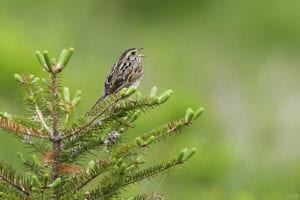
Savannah Sparrows and Lincoln’s Sparrows are the most visually similar to Song Sparrows, with similar striping on the crown, throat, back, and breast. Savannah Sparrows are more white, with thinner brown streaking, and usually have a distinctive yellow spot above the eye. They also prefer more open habitats than Song Sparrows, like large lawns or agricultural fields. Lincoln’s Sparrows nest in willow shrubs in boreal Maine and Canada, and are only encountered during migration in most of the state. They have the thinnest streaking of these three, almost like it was drawn on with a pen, and are distinctly tan on the front and sides. So when confronted with an unknown Song-like sparrow, it is useful to look for yellow around the eye and tan on the front in order to rule out Savannah and Lincoln’s Sparrows.
Fox and Swamp Sparrows are also more common during migration than during winter, and have useful distinctions to separate them from Song Sparrows. Both species tend to be found in or near wet habitats, even during migration. Fox Sparrows are the largest sparrow species discussed here, and are the most reddish-brown of any of these species. They have similar patterning to Song Sparrows but much more bold, saturated coloration, and thick streaking on the front that resembles the spotting of thrushes. Swamp Sparrows look the least like any of the sparrows discussed so far, with relatively clean gray fronts, orange-brown wings and back, faint throat striping on a whitish throat, and reddish brown crown stripes alternating with gray. They could potentially be confused with the next two groups of sparrows, but can be distinguished from the others in this group by the combination of generally unstreaked, gray fronts and rufous crown stripes.
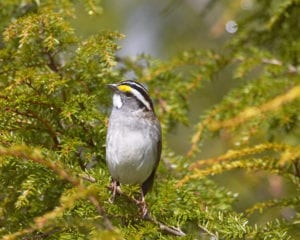
White-throated Sparrows and White-crowned Sparrows belong to the genus Zonotrichia, and share rufous-brown streaked backs and wings, unstreaked gray fronts, and bold crown striping in black or brown. White-throated Sparrows are common throughout winter, especially in coastal Maine, and are distinguished by their white throats (framed by dark throat stripes), and yellow spots above the eye, similar to Savannah Sparrows. White-crowned Sparrows are only encountered during migration, and can be identified by their clean gray throats and cheeks.

American Tree Sparrows and their lookalikes (and former congeners) in the genus Spizella, like Chipping Sparrows and Field Sparrows, all share reddish caps (or crown stripes that look like caps), reddish streaked wings and back, clean gray fronts, and whitish throats with no prominent throat stripes. They also prefer open habitats for feeding, especially lawns, trails, and meadow edges. Conveniently, most Chipping and Field Sparrows are gone by the time American Tree Sparrows show up in November, so there are few opportunities to confuse these similar species.
The species discussed here share many similarities, but careful observation, especially when the species occur together, can allow them to be more easily recognized. Try and spend some time watching sparrows hopping under the feeder this winter, and you will be able to tell a White-throated Sparrow from a Song Sparrow in no time.
